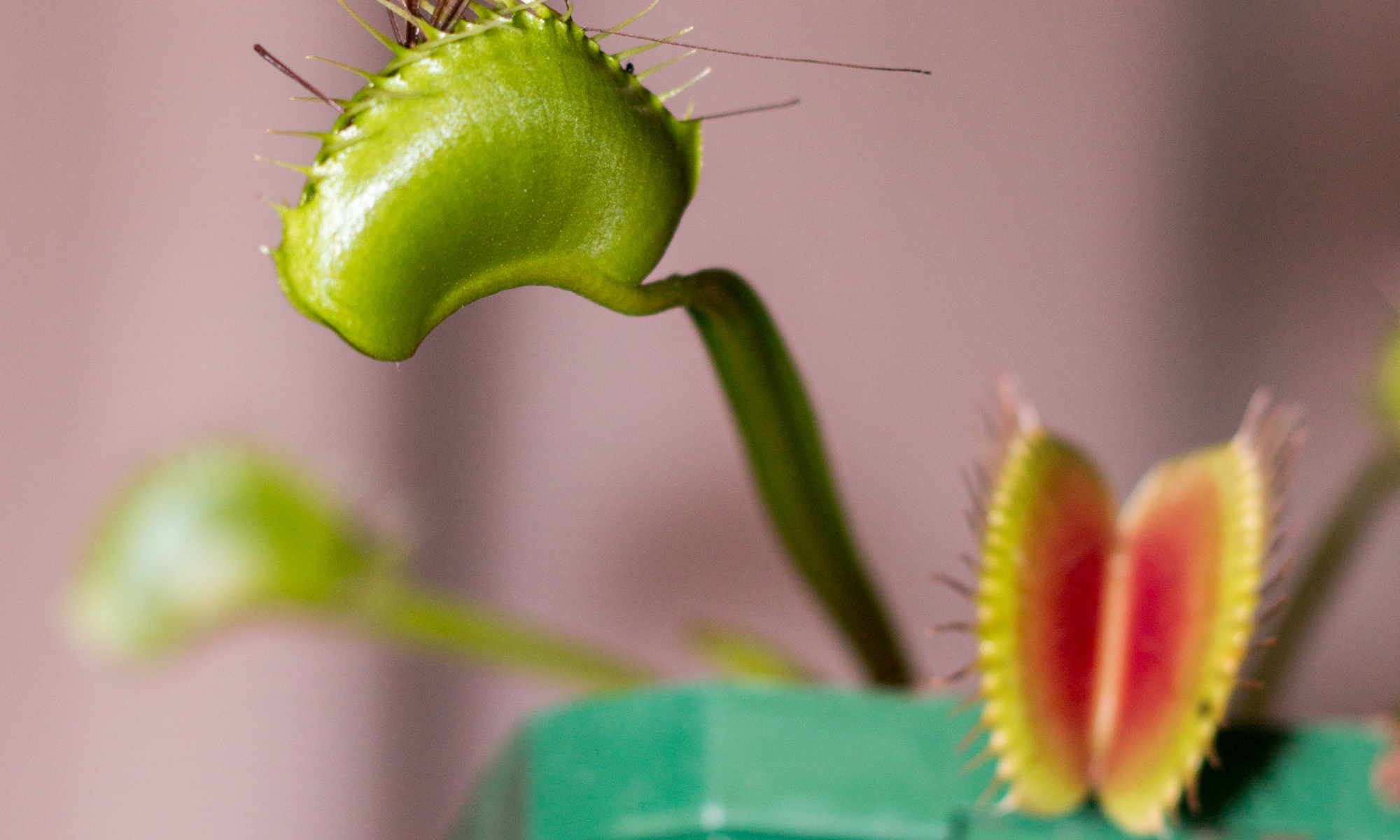Ever thought about making a Venus fly trap terrarium?
They’re easy to make, and a super fun “pet” to add to maybe your desk, or other assortment of indoor plants.
In this article we’re covering how to make a Venus fly trap terrarium, how to care for it, and why they’re a great plant for your indoor garden.
Table of Contents
Why we love Venus Fly Traps
Venus flytraps are a fun plant for reasons you’ve probably heard of. This plant is carnivorous and can eat small insects, which makes it unique from (probably) most plants that you have already.
Venus fly traps have a reputation of being difficult to care for. However, provided you have the right setup, once you get the hang of it they’re not any more difficult than your average houseplant.
What you’ll need
Lets cover the basic materials for making Venus fly trap terrarium.
Soil
Venus fly traps are particular with their soil. They thrive in soil that will stay damp, but still provide ample drainage. We recommend avoiding typical potting soil.
Instead, a mix of 50% peat moss and 50% sand will allow your Venus fly trap to thrive. You can either mix it yourself, or buy a pre-made mix like this carnivorous plant soil for your Venus fly trap terrarium.
Terrarium Container
Selecting your Venus fly trap terrarium container is one of the most fun parts of the process. You can pick something simple and classic, or something fun and unique. You can also plant Venus fly trap in a normal pot – it doesn’t have to be enclosed in a glass dome like a typical terrarium would be.
A few options for terrariums are below, but feel free to choose your own! Be as creative as you like with selecting the terrarium. An ideal size is 10cm in diameter for one plant, or 20cm if you’re planting 2.
Our Top Picks of Terrarium Containers
Banord Black Tabletop Terrarium
Set of 3 Hanging Wall Terrariums
Luckyslife Geometric Glass Terrarium
Accent Plants
This part is totally optional, but if you’d like accent plants in your Venus fly trap terrarium then feel free to add additional plants too!
Moss makes a great addition to the terrarium to create a complete look.
Venus Fly Trap
Last, but certainly not least, you of course need a Venus fly trap for your terrarium. These plants have increased in popularity lately so they’re relatively easy to find.
Your local gardening store or even places like Home Depot or Lowes might have them. Its best to call ahead and check though just in case, as some times of the year they’re not offered. We’ve even seen them in the gardening sections of Walmart!
You can also of course order a Venus fly trap online. Amazon sells Venus Fly traps, but you may end up paying a premium compared to what you would pay in person.
Creating Your Venus Fly Trap Terrarium
After you’ve assembled all of your materials, creating a Venus fly trap terrarium is pretty simple.
You’ll start by creating a base layer of soil in your terrarium. Then simply planting the Venus fly trap, and other accent plants as you desire. Carefully remove your fly trap from its temporary planter and place in the terrarium, then arrange the other components as desired.
In our next section we’ll cover maintenance of your Venus fly trap terrarium and how to care for your new plant.
Caring for your Venus Fly Trap
Lets go over some common questions and care for your Venus fly trap.
Do I need to feed it?
Probably the first question you’ll ask is how to feed your new carnivorous plant. Its true, fly traps do like to eat small insects like flies, spiders, and other bugs.
However, Venus fly traps really only need to eat every 1 – 2 months. So even indoors, they can usually manage feeding on their own without you having to hand feed them. You can also place them outdoors on a patio or window box and they’ll feed themselves.
If you’re concerned, you can of course feed your plant by hand. They’ll appreciate the extra effort!
Light
Venus fly traps will do best in bright, indirect sunlight indoors. Be careful not to place in direct light as this can damage the plant.
Read also: Best Grow Lights for Small Spaces
Watering
Venus fly traps require the soil to remain fairly moist, but provide ample drainage.
As we mentioned in an earlier section, its great to have a mix of 50% peat moss and 50% sand to create the right environment for your fly trap. When watering them, thoroughly soak the soil to ensure its damp all the way through. Let the soil get moderately dry before watering again.
Venus fly traps do need close to pure water, meaning that depending on what region you live in tap water may not be suitable for your plant.
Similarly, bottled water can often have added minerals too. The best option to use when watering your Venus fly trap is either rain water or distilled water.
Fertilizer
Venus fly traps do not require any fertilizer!
This is another reason to avoid potting soil, as they often have added nutrients already mixed in. No need to worry about adding plant food or any type of fertilizer once planted though. Venus fly traps gather the nutrients they need from air and insects they consume.
Temperature
Venus fly traps thrive at room temperature, no need to adjust your room’s conditions for their benefit!
Avoid Poking your Venus Fly Trap
One lesser known fact is that you can actually harm your flytrap by continuously poking the traps. Poking can trigger the trap to close, essentially because the fly trap thinks that its caught some food to digest.
After poking though, it can take the plant up to 24 hours to reopen the trap, meaning it will miss any insects that cross its path in between. Also, some traps after being poked never reopen, which damages the plant in the long run.

Interested in other types of terrariums? Marimo Moss balls can also be put in terrariums, similar to Venus fly traps! Check out our Complete Care Guide for Marimo Moss Balls for more info.







Thank you for this information! I just got my first VFT and will be making it’s terrarium this week, wish me luck!
Ah, good luck! Let us know how it goes!!